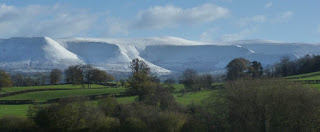Most of you are probably aware that I rather enjoy being out in nature with my sketchbook and a Danish pastry (that’s a cake, of course, not a Scandinavian model). I always try to plan my excursions to coincide with the optimum conditions for my objectives, so last weekend I decided to go over to the Mid-Wales Fjordenland to sketch the snow-covered hills and filled-up reservoirs. This is an area more commonly known as the Elan Valley, a sort of Welsh lake district. With all the rain we have experienced in December and early January I hope to see scenes I have not witnessed for many years: the reservoirs so full that those hideous margins between the landscape and water are covered over.
Sure enough, the reservoirs looked stunning, even without the help of the sun, with Garreg-ddu reservoir (on the right) looking especially magnificent. So, it pays to choose your moment, in this case after heavy rains when the water is high in rivers, lakes and reservoirs and waterfalls are really at their best. Leave it for the hot days of summer and you are quite likely to encounter just a trickle of a waterfall! I didn’t get an opportunity to sketch this scene as the light was fading and I was parked in an awkward spot, so I might return soon on a better day and render it in watercolour.
I did, however, spend some time sketching other subjects, one of which was done in watercolour. As I began the sketch it started to rain, and kept raining until I put it away and then it stopped. That is pretty much par for the course!
Much of the intensity of the colours has washed off, but the black watercolour pencil has kept the image intact. I did this from a rough patch of ground mainly covered in dead bracken. There was no path and the charm of these places from the artists’ point of view is that the awkward approach inhibits most other people from coming over to see what you are up to. An advantage of days like this is that if you wear a large hood it isolates you from the voyeurs and can impart a sort of mysterious non-gender type of person to others – a great advantage!







